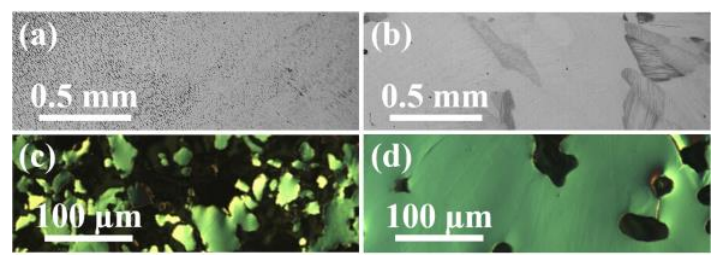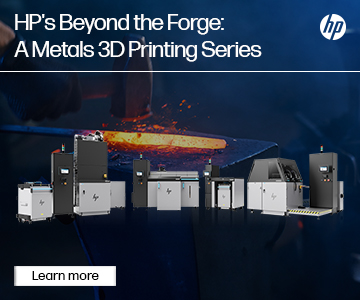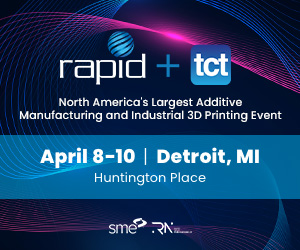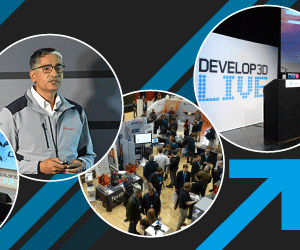Making Magnetic Materials at University of Pittsburgh: Binder Jet 3D Printing vs Laser Metal Deposition
Researchers from the University of Pittsburgh explore the ever-expanding world of benefits via 3D printing, detailing their work in the recently published ‘Additive Manufacturing: Opportunities and Challenges for Functional Magnetic Materials.’
While the manufacturing realm is undoubtedly undergoing a transformation, there are still numerous challenges to be overcome regarding 3D printers, 3D printing software, and a wide range of materials, from thermoplastics to metal, and beyond.
Manufacturing with magnetic materials is not unheard of—from printing with composites to magnetic blocks and other innovations—yet as the researchers point out in their research, AM of magnetic shape memory and magnetocaloric materials ‘has yet to be developed as a manufacturing option,’ despite the potential for use in so many different applications.
For this study, the authors experimented with binder jet 3D printing (BJ3DP) and laser metal deposition (LMD). Crushed and ball-milled powder was used in the form of melt-spun ribbon (Ni-Mn-Co-Sn), polycrystalline ingots (Ni-Mn-Ga, Ni-Mn-Cu-Ga) and single crystals (Ni-MnGa).
The researchers sieved it for their purposes in the research study, manipulating the sizes for the best printing with BJ3DP (using an ExOne Lab system) and LMD (using an Optemec LENS® 450 LMD system). Samples were fabricated and then held up in comparison to homogenized counterparts.
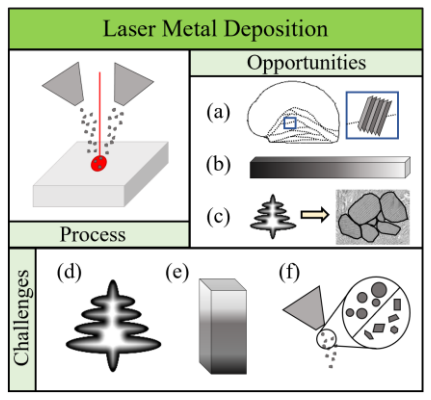
LMD has distinct opportunities and challenges including (a) grains grow epitaxially from substrate over multiple print layers, (b) gradient properties are possible, (c) heat treatment homogenizes samples; (d) Microsegregation and dendritic microstructure, (e) property variation, (f) powder feeding difficulties for non-spherical powder
While the researchers enjoyed the benefit of being able to use several different powders, along with in-situ parameter tuning permitting gradient structures, there were also challenges in using the LMD technique:
“Gradient structures are desired in some applications, but variation of structure and properties within parts might be a challenge. The irregularly-shaped ball-milled powder is easily produced but shows inconsistent flow rates through the powder feeders and, therefore, inconsistent built shapes, unlike ideal spherical powder,” explained the researchers.
In experimenting with BJ3DP, the researchers noted that bulk density could be varied as they manipulated the parameters; however, there was an issue with shrinkage.
“Though structural applications require high density, functional magnetic materials can benefit from porosity. By not melting the powder during printing the original composition of the powder remains intact, and residual thermal stresses are not developed,” explained the authors.

Major opportunities and challenges of BJ3DP are as follows: (a) controlled, multimodal porosity, (b) consistency of composition, (c) absence of thermal stresses; (d) binder effects, (e) powder challenges, (f) shrinkage during sintering.
Overall use of BJ3DP revealed challenge not only with shrinkage but also binder and powder effects, with droplets being deposited onto the bed in a variety of ways depending on the powder—and the size of the droplets.
“While many challenges exist for each AM method discussed and not discussed here, there are also many advantages,” concluded the researchers.
“Depending on the AM method, increased complexity in shape, the ability to design and target constant and gradient composition and properties and designed bi-modal porosity are a few of the new possibilities available. These benefits present the potential of expanding functional magnetic materials to new, currently impossible applications.”
What do you think of this news? Let us know your thoughts! Join the discussion of this and other 3D printing topics at 3DPrintBoard.com.
[Source / Images: ‘Additive Manufacturing: Opportunities and Challenges for Functional Magnetic Materials’]Subscribe to Our Email Newsletter
Stay up-to-date on all the latest news from the 3D printing industry and receive information and offers from third party vendors.
You May Also Like
Italy’s Da Vinci Bridge Reinvented with 3D Printing and Stone Waste
Italy’s city of Bari has inaugurated a new 3D printed, self-supporting bridge that, for the first time, uses waste materials from stone processing. This structure, known as Da Vinci’s Bridge,...
3DPOD 233: Sustainable Manufacturing with Kate Black, Atomik AM
Kate Black is the Chief Executive Officer of Atomik AM, where she leads a team dedicated to fostering innovation and developing integrated advanced manufacturing solutions. The company specializes in electronics...
ESA Funds Horizon Microtechnologies’ Metallized 3D Printed Electronics Parts
German small-scale manufacturing expert Horizon Microtechnologies has received the European Space Agency (ESA)’s Spark funding to apply its specialty metallization technology to space applications. The firm believes its parts can...
3DPOD 228: Filament and Print Services with Trent Esser, Printerior
Trent Esser founded Printerior with his partners and has since pivoted and redefined the company’s focus multiple times. Printerior operates as a 3D printing service that both sells and recycles...


